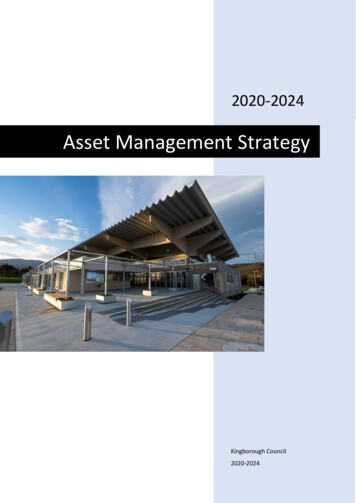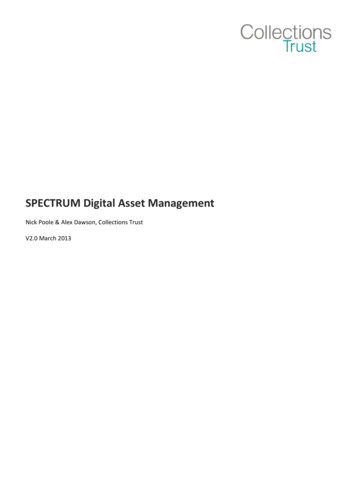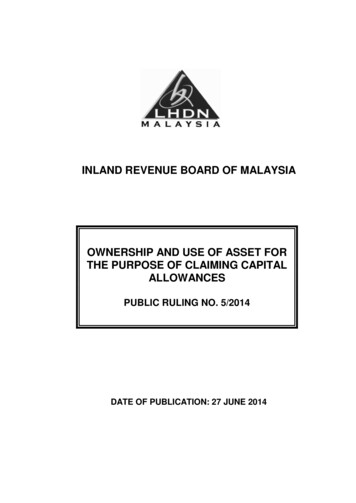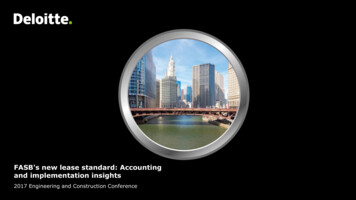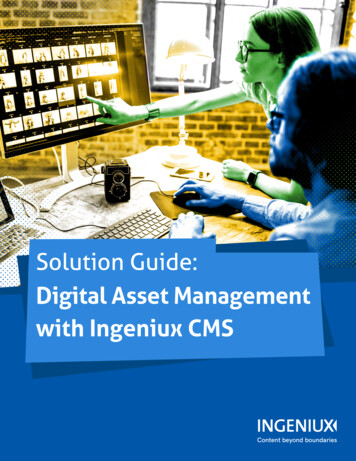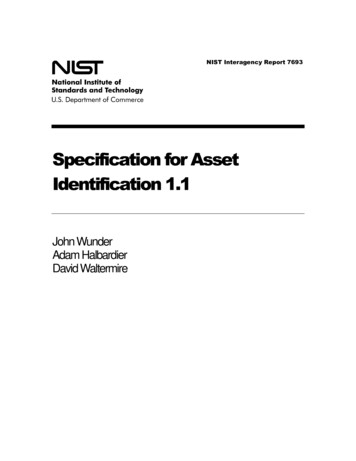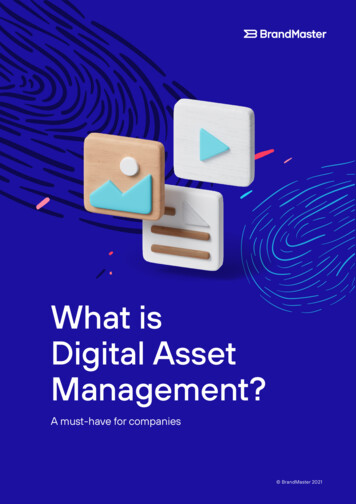
Transcription
What isDigital AssetManagement?A must-have for companies BrandMaster 2021
W H Y S H O UL D YO U RE AD T H IS WH IT E PAPE R?Regardless of what role you have in your company, you deal withdigital assets every day. Creating them, looking for them, usingthem, paying for them, or perhaps you are even responsible for ITinfrastructure? Either way, digital assets are part of your workday.Most companies will claim that they have control of all their assets,but this usually changes once we take a deep dive into their setup.The fact is, companies rarely have the insight into how many assetsthey actually have, or even what assets they have. We often findthat companies have their assets scattered all over the placeand there is now real ownership. The cost related to lack of assetcontrol is huge, but unknown.This paper highlights the importance of a DAM system and how itmakes an impact on company efficiency and expense control.2
In this paper.DAM – A must have 5What’s the fuss about assets? 6What are digital assets? 7This is Digital Asset Management 8The importance of proper Digital Asset Management 9Why you need Digital Asset Management? 10How lack of the basics impacts your company 11The benefits of Digital Asset Management 12What capabilities should you look for in a DAM system? 14In summary 16Cost saving example 17— Company business case - Looking at digital asset costsWhat is Digital Asset Management? A must-have for companies3
4
DAM – A must haveIf you do a quick assessment, you will quickly find out that the amount of assets your company have,it enormous. Every employee, every department continuously produce content that is of value toyour company – basically created for a company purpose.So, why is DAM a must have?Because you want to have control of these assets, knowing what and where you have them stored. Tocut it short, the better you manage these assets, the more efficient and streamlined everyone in yourcompany can work. Employees do not have to create something that already exists and looking for assetsis easy. Let’s take a closer look.What is Digital Asset Management? A must-have for companies5
What’s the fuss about assets?In our encounters with companies and their brands, we are often told that they have full control of theirdigital assets, but a closer look usually tells us otherwise. Even large brands sometime surprise us withthe lack of asset control.It often starts with lack of company standardization. Every employee and team have created their ownsystem or logic for saving and sharing files amongst themselves. It works for a short amount of time, butwe would argue that it is not a sustainable solution in the long run.“Asset”, a simple word that in its widest meaning entails every file ever created by an employee underyour brand. At first glance it might not seem like a lot, but it requires a thorough mapping to get the realinsight into what actually exists.It is not uncommon that companies areunaware of what assets exists, or the amount,and for years companies have managed theiroperations without any special thoughts toassets. So why start bothering now?Of course, every asset has a level ofimportance, and some are more importantthan others. However, as long as an assetis created for a company purpose, it leavestraces of costs and value. How you treat yourassets makes an impact on your operationalefficiency, expenses and your brand.6
What are digital assets?Contracts, documents, presentations, agreements, images, logos, videos, sounds, brochures, illustrationsand more are all digital assets. Basically, any file created by employees or teams in your company areconsidered digital assets.In 2020 the DAM market was valued to USD 2962.2 million and is expected to reach USD 9164.96 million1by 2026 . This is a massive growth and the reason for this estimation is the digital space we work in andthe number of formats and versions we have to deliver with our marketing and brand initiatives. If youdon’t have a proper system for managing your assets, you will quickly loose control of your assets goingforward If you haven’t already done so?What is Digital Asset Management? A must-have for companies7
This is Digital Asset ManagementDigital Asset Management is the technology that helps to collect, store, structure, and distribute anydigital asset in a company – in one central location. It is built on the logic of both easy back end andfront-end capabilities. By providing any employee or stakeholder one source of truth, with easy searchand use capabilities while the file creators have straightforward file administration functionalities.There are a ton of digital asset management system providers, all with different features and capabilitiesyou need to be aware of when choosing your system.8
The importance of proper Digital AssetManagementManaging assets properly is not only essential for the marketing department, it is a necessity for theentire company. As we mentioned initially, any asset created for a purpose is a valuable, and it is in thecompany’s own interest to protect all assets properly. In other words, the decision of where and how tostore assets needs to be a management decision, and some standard principles need to be defined. Ifnot, employees and teams will just go on and do as they prefer.What is Digital Asset Management? A must-have for companies9
Why you need Digital Asset Management?There are four key components that lays the foundation for why digital asset management technology exist.StorageThere are endless ways to store assets. On your desktop, company folder,software such as Dropbox or Adobe Cloud, with your creative agencies, etc.Without standardization, every team and employee will store the assets theycreate as they prefer. How can you possibly get the full overview of your assetswhen they are scattered all over the place?StructureIf everyone can do as they please, there will be no company logic behindstructuring assets properly. What is logical for one employee is not necessarilylogical for another. Finding and searching for assets will be a nightmare.AccessWithout a proper system, making sure that everyone has access to all assets willbe impossible. Who provides the access? And how does anyone know where toaccess assets if they are stored in multiple locations?DistributionFinally, with the lack of all the above, distributing assets is challenging. If theasset you need exist, can you find it? Can you access it? And can you find theformat and file type that you need? Do you have to involve colleagues to attainan asset? Can it be sent by email or is the file size too large?10
How lack of the basics impacts yourcompanyThe if’s and but’s above is one thing, but let’s take it one step further, how does it impact your company?Again, assets are valuables. They have been created either by an employee or an agency, time and moneyhas been spent. And without the necessary asset control, it impacts your budget and resources.Assets get lostAsset re-creationEmployees come and go. If storing assets areWhen there is no common ground for where toconnected to each employee, you will neverfind assets, the likelihood of employees creatingknow the amount of assets you have or whatalready existing assets are huge. It’s as simpleassets exist. The chances are that asset will getas this: If you don’t know that it exists, you willlost when employees leave. Not only do you losedefinitely not start looking for it. And if you did,the assets, the time and money spent on creatingwhere do you start looking? Time looking is onethe assets are also gone and will most likely bething, time re-creating is another. You doublespent all over again on recreating something thatyour expenses without knowing it And all foralready existed.nothing.Increases hidden costsReduces company efficiencyBoth lost assets and re-creating assets has oneHow it affects your expenses is one thing, butthing in common, it increases your company’sthink about the time that goes to waste searchinghidden costs. You have already spent money onand looking for files before you even think aboutthe assets, why would you want to spend it again?creating a new one? A completely unnecessaryWell, if you don’t know that the asset existed, youfactor in a fast-moving world, where time alwaysdon’t know that it is an extra cost is of essence.What is Digital Asset Management? A must-have for companies11
The benefits of Digital Asset ManagementOwn and protect assetsAssets are intellectual property and holds a value. By standardizing how you manage assets,you are taking control of the assets from a company threshold, instead of the individualemployee. Regardless of who created the asset, the asset is stored in one central locationfor everyone to access and use.Streamline company operationsWhen everyone is working in the same system where structure and workflows are establishedbased on company needs, time spent searching for assets in eliminated. Everyone canaccess and download the needed assets without involving anyone. Instead, you have simple,straightforward operations.Decrease hidden costsAs mentioned, hidden costs are no stranger when it comes to digital assets. However, with aproper system in place, this is no longer an issue. When all assets are collected and structuredin one single place, finding assets will be easy and losing assets is a thing of the past.Decrease time to marketWe live in a digital world where everyone demands fast and prompt deliveries. Spendingtime on looking for assets, is time you don’t have. Afterall, you have deadlines to meet. Witha digital asset management system in place, delivery is done in a heart beat.Establish brand consistencyEven though a digital asset management system is a necessity for an entire company, thesignificance it has for the marketers in the company is unquestionable. A considerablepercentage of the digital assets a company owns, are brand assets. Essential assets that,when combined,turns into the brand identity. Without going into too many details, a strongbrand derives from continuous consistency. By making your assets available from one singlelocation, your brand will stay the same everywhere.12
What is Digital Asset Management? A must-have for companies13
What capabilities should you look for in aDAM system?You need to think both back and front-end capabilities when you are looking for a DAM system. Bothsystem owners and end-users will need a system that meets their expectations today and in the future,and user-friendliness is a no-brainer. So, what should you keep an eye out for?FlexibilityEvery company is different, thus have different needs. Look for asystem that allows you to establish a digital asset managementsolution that fits your needs. You need to have the ability tostructure your assets as you see fit, and you need to establishuser-flows that reflects how your company operates.Easy maintenanceWhen it comes to assets, version control, expiration dates,copyrights, meta data and more is essential details you needto consider. The easier this is to manage, the easier it is tokeep your digital assets valid and up to date. Don’t’ take thislightly, look for a system that allows you to manage asset dataseamless and easy. If you fail on maintenance, your DAM systemwill quickly be out of date, and asset reliability goes down thedrain You’ll be back where you started.Access controlIt is never a good idea to give everyone access to everything.Make sure you get a system that allows you to control accessbased on your company needs. Departments, employees,external stakeholders, across countries. Think both horizontaland vertical access control.14
Smart cropImages are popular assets, but an image out of proportion orwrongly cropped does not do anything good for your brand. Bypre-setting how an image can be cropped and having smartcrop functions recognizing focus content in the images, yourimages will always stay professional.Automatic file transcodingHistorically one file has usually been saved in multiple filetypes or formats. This has been cause for not only a lot of workcreating all these files, but it is also cause for heavy maintenanceand administration. With a proper digital asset managementsystem, this is automatically handled. File owners only haveto upload one file, and the system will take care of the output.Smart uploadImagine there will be more than one person uploading filesto your DAM system. Perhaps you will also allow externalstakeholders such as creative agencies to upload files directly.You need to make sure your system is set up to handle uploadswithout breaking the asset structure. Some companies havean approval workflow in place before assets are published todesignated destination, others pre-set upload values defined bytype of file. The more people who will upload files, the smarteryou must be about it. Make sure you choose a system that isprepared, otherwise your assets will be a mess.What is Digital Asset Management? A must-have for companies15
Dynamic search functionalitiesSearch functions are more complicated than you think. Makesure to have a system that help users search for files andnarrowing down search based on logical filters rather than afilename. Afterall, you can not expect everyone to know whatevery file is named.System integrationsRarely, static digital assets are not enough to keep acompany going. Adjustments and tailoring might come inhandy. Make sure to look for a system that can be poweredby template technology, allowing assets to be adjusted tofit local needs without compromising the brand identity.And if you need your assets to be either orderable or printedlocally, make sure you look for a system that handles this as well.Improve workflows and usabilityFinally, make sure you can put your assets into context. Thebetter you can present your assets and put them into usercontext, the easier it will be for your end-users. Perhaps youdon’t see the need today, but it is always wise to think long-term.Perhaps you want to power your website with assets directlyfrom your DAM system, or maybe you want to have online brandguidelines later down the line. Make sure you don’t narrow youroptions even though you don’t have the need today.16
In summaryThere are plenty of reasons why Digital Asset Management is a must-have for companies and hopefullyyou now have a better understanding of what this does for your brand and your company.There are plenty of DAM systems available in the market, some even free. But before you make up yourmind, make sure you do a thorough analysis of your company needs, and think long-term. The fast-evolvingMartech space will not slow down, so when you decide to invest, make sure your investment is reflectingfuture needs as well, and make it worthwhile.If you need to back up your research and evaluation with numbers, check out our ROI calculator. You’llbe amazed of how much time and resources that goes to waste managing digital assets.Here’s a sneak peek.What is Digital Asset Management? A must-have for companies17
Cost saving exampleCompany business case - Looking at digital asset costsAll 20 employees need assets on a20401 50 1001000EmployeesHourly weekMarketing teamAverage labour costAverage agency rateregular basisThey each spend 30 min. a daylooking for assetsThe amount of assets never foundis 10 per weekAgency time counts for 1 hour perasset re-creationsTotal assetsTotal cost 72,000a yearWith aDAM systemSave 50.400 per yearWith aDAM systemGet 70%more time18
Endnotes1https://www.researchandmarkets.comWhat is Digital Asset Management? A must-have for companies19
About BrandMasterWhen we set up our company in Oslo back in 1998, we did so with a clearfocus: to help marketing teams manage their workflows and build strong,sustainable brands. Our team of digital designers, marketers, developers andbrand consultants created a system which would redefine how things are doneand give clients the tools and know-how to up their game. They were quick torecognise the operational and commercial benefits this would bring and ourvision soon became a viable business. That was then and we’ve never lookedback. Today, BrandMaster has evolved to become a market-leading, modularmanagement platform, trusted by global enterprises, successful brands andambitious start-ups. As for us, we still work from our HQ in Oslo and you’ll alsofind us across Europe and the US.Author: Renate Sandland Henriksen, Marketing Responsible @BrandMaster BrandMaster 2021
This is Digital Asset Management Digital Asset Management is the technology that helps to collect, store, structure, and distribute any digital asset in a company - in one central location. It is built on the logic of both easy back end and front-end capabilities.
